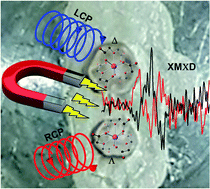Hard X-ray magnetochiral dichroism in a paramagnetic molecular 4f complex†
Abstract
Magnetochiral dichroism (MΧD) originates in the coupling of local electric fields and magnetic moments in systems where a simultaneous break of space parity and time-reversal symmetries occurs. This magnetoelectric coupling, displayed by chiral magnetic materials, can be exploited to manipulate the magnetic moment of molecular materials at the single molecule level. We demonstrate herein the first experimental observation of X-ray magnetochiral dichroism in enantiopure chiral trigonal single crystals of a chiral mononuclear paramagnetic lanthanide coordination complex, namely, holmium oxydiacetate, at the Ho L3-edge. The observed magnetochiral effect is opposite for the two enantiomers and is rationalised on the basis of a multipolar expansion of the matter–radiation interaction. These results demonstrate that 4f–5d hybridization in chiral lanthanoid coordination complexes is at the origin of magnetochiral dichroism, an effect that could be exploited for addressing of their magnetic moment at the single molecule level.



 Please wait while we load your content...
Please wait while we load your content...